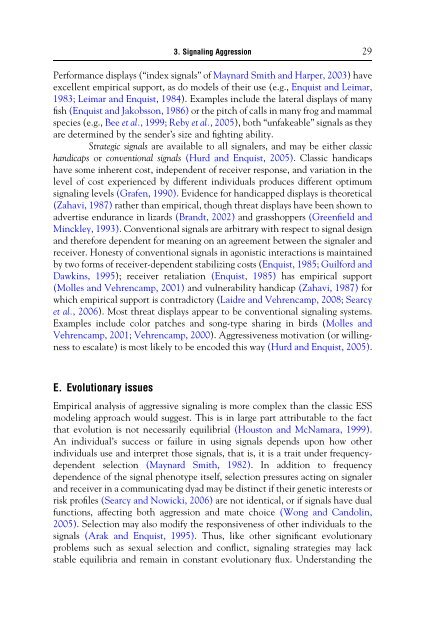full text - Caspar Bgsu - Bowling Green State University
full text - Caspar Bgsu - Bowling Green State University
full text - Caspar Bgsu - Bowling Green State University
Create successful ePaper yourself
Turn your PDF publications into a flip-book with our unique Google optimized e-Paper software.
3. Signaling Aggression 29<br />
Performance displays (“index signals” of Maynard Smith and Harper, 2003) have<br />
excellent empirical support, as do models of their use (e.g., Enquist and Leimar,<br />
1983; Leimar and Enquist, 1984). Examples include the lateral displays of many<br />
fish (Enquist and Jakobsson, 1986) or the pitch of calls in many frog and mammal<br />
species (e.g., Bee et al., 1999; Reby et al., 2005), both “unfakeable” signals as they<br />
are determined by the sender’s size and fighting ability.<br />
Strategic signals are available to all signalers, and may be either classic<br />
handicaps or conventional signals (Hurd and Enquist, 2005). Classic handicaps<br />
have some inherent cost, independent of receiver response, and variation in the<br />
level of cost experienced by different individuals produces different optimum<br />
signaling levels (Grafen, 1990). Evidence for handicapped displays is theoretical<br />
(Zahavi, 1987) rather than empirical, though threat displays have been shown to<br />
advertise endurance in lizards (Brandt, 2002) and grasshoppers (<strong>Green</strong>field and<br />
Minckley, 1993). Conventional signals are arbitrary with respect to signal design<br />
and therefore dependent for meaning on an agreement between the signaler and<br />
receiver. Honesty of conventional signals in agonistic interactions is maintained<br />
by two forms of receiver-dependent stabilizing costs (Enquist, 1985; Guilford and<br />
Dawkins, 1995); receiver retaliation (Enquist, 1985) has empirical support<br />
(Molles and Vehrencamp, 2001) and vulnerability handicap (Zahavi, 1987) for<br />
which empirical support is contradictory (Laidre and Vehrencamp, 2008; Searcy<br />
et al., 2006). Most threat displays appear to be conventional signaling systems.<br />
Examples include color patches and song-type sharing in birds (Molles and<br />
Vehrencamp, 2001; Vehrencamp, 2000). Aggressiveness motivation (or willingness<br />
to escalate) is most likely to be encoded this way (Hurd and Enquist, 2005).<br />
E. Evolutionary issues<br />
Empirical analysis of aggressive signaling is more complex than the classic ESS<br />
modeling approach would suggest. This is in large part attributable to the fact<br />
that evolution is not necessarily equilibrial (Houston and McNamara, 1999).<br />
An individual’s success or failure in using signals depends upon how other<br />
individuals use and interpret those signals, that is, it is a trait under frequencydependent<br />
selection (Maynard Smith, 1982). In addition to frequency<br />
dependence of the signal phenotype itself, selection pressures acting on signaler<br />
and receiver in a communicating dyad may be distinct if their genetic interests or<br />
risk profiles (Searcy and Nowicki, 2006) are not identical, or if signals have dual<br />
functions, affecting both aggression and mate choice (Wong and Candolin,<br />
2005). Selection may also modify the responsiveness of other individuals to the<br />
signals (Arak and Enquist, 1995). Thus, like other significant evolutionary<br />
problems such as sexual selection and conflict, signaling strategies may lack<br />
stable equilibria and remain in constant evolutionary flux. Understanding the



